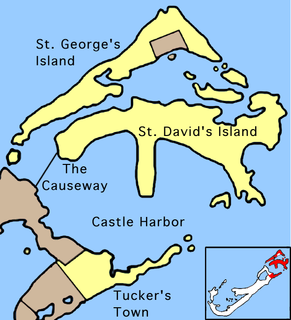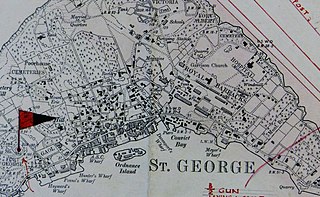
While Bermuda technically remains the responsibility of the government of the United Kingdom, rather than of the local Bermudian Government, the island still maintains a militia for the purpose of defence.

Sir Thomas Gates, was the governor of Jamestown, in the English colony of Virginia. His predecessor, George Percy, through inept leadership, was responsible for the lives lost during the period called the Starving Time. The English-born Gates arrived to find a few surviving starving colonists commanded by Percy, and assumed command. Gates ruled with deputy governor Sir Thomas Dale. Their controlled, strict methods helped the early colonies survive. Sir Thomas was knighted in 1596 by Robert Devereux, 2nd Earl of Essex for gallantry at the Capture of Cadiz. His knighthood was later royally confirmed by Queen Elizabeth I.

St. George's Parish is one of the nine parishes of Bermuda. It is named after the founder of the Bermuda colony, Admiral Sir George Somers.

Hamilton Harbour is a natural harbour in Bermuda which serves as the port for the capital, the City of Hamilton. It is an arm of the Great Sound, and forms a tapering wedge shape of water between Paget Parish and the peninsula which forms Pembroke Parish, and upon which the capital sits.

Ordnance Island is located within the limits of St. George's town, Bermuda. It lies close to the shore opposite the town square, in St. George's Harbour.
The following is a list of places of interest in Bermuda.

Bermuda has organised several different forms of militia between the 1612 and 1815. The roles of the militias included defence of the colony in complement with the activities of the British Army and Royal Navy.

Several of the islands strung across the South entrance of Castle Harbour, Bermuda were fortified in the early days of the territory, hence the harbour's name. When official settlement of the archipelago by England began in 1612 the first permanent town, St. George's was placed on the North side of St. George's Harbour. St. George's Harbour could be accessed directly by channels from the East. Those channels, however, were shallow, suitable, originally, only for small ships. As a consequence, and despite any major settlement on its shores, Castle Harbour was an important anchorage in the early years of the colony, with its main entrance, Castle Roads being an important route in from the open Atlantic for shipping. It was also a weakpoint, as it was remote from the defences of St. George's Harbour, and difficult to reach. It was quickly fortified and garrisoned by a standing militia.

The Bermuda Garrison was the military establishment maintained on the British Overseas Territory and Imperial fortress of Bermuda by the regular British Army and its local militia and voluntary reserves from 1701 to 1957. The garrison evolved from an independent company, to a company of Royal Garrison Battalion during the American War of Independence, and a steadily growing and diversifying force of artillery and infantry with various supporting corps from the French Revolution onwards. During the American War of Independence, the garrison in Bermuda fell under the military Commander-in-Chief of North America. Subsequently, it was part of the Nova Scotia Command until 1868, and was an independent Bermuda Command from then 'til its closure in 1957.

The Bermuda Volunteer Engineers was a part-time unit created between the two world wars to replace the Regular Royal Engineers detachment, which was withdrawn from the Bermuda Garrison in 1928.

Fort St. Catherine, or Fort St. Catherine's, is a coastal artillery fort at the North-East tip of St. George's Island, in the Imperial fortress colony of Bermuda. Successively redeveloped, the fort was used first by Bermudian Militia and then by regular Royal Artillery units from 1612 into the 20th century. Today it houses a museum.

The Historic Town of St George and Related Fortifications is the name used by the United Nations Educational, Scientific and Cultural Organization's (UNESCO) World Heritage Committee to identify collectively as a World Heritage site St. George's Town, founded in 1612, and a range of fortifications, batteries, and magazines built between 1612 and 1939, the last of which was removed from use in 1953.

St. David's Battery, also known during wartime as the "Examination Battery", was a fixed battery of rifled breech-loader (RBL) artillery guns, built and manned by the Royal Garrison Artillery and the Royal Engineers, and their part-time reserves, the Bermuda Militia Artillery and the Bermuda Volunteer Engineers, part of the Bermuda Garrison of the British Army.

The Western Redoubt, or Fort William, is a square fort built on a crest on the eastern side of Government Hill, and within the boundaries of the original main British Army camp in the Imperial fortress colony of Bermuda, St. George's Garrison.

Fort Victoria is a disused British Army fort, built to house coastal artillery atop Retreat Hill, within St. George's Garrison, at the North-East of St. George's Island, in the British colony of Bermuda.

HMS Castle Harbour was a civilian harbour vessel of 730 tons that was taken-up from trade (TUFT) during the Second World War by the Royal Naval Dockyard in Bermuda for use by the Royal Naval Examination Service and later armed and commissioned as a warship, providing harbour defence from submarines.

St. George's Garrison was the first permanent military camp of the Bermuda Garrison established in the British colony and Imperial fortress of Bermuda, with construction of Old Military Road and the original Royal Barracks commencing during the war between Britain and France that followed the French Revolution. It would remain in use until 1957, when it was transferred to the civil (colonial) government with most of the other Admiralty and War Office properties in Bermuda.

Imperial fortress was the designation given in the British Empire to four colonies that were located in strategic positions from each of which Royal Navy squadrons could control the surrounding regions and, between them, much of the planet.

Scaur Hill Fort, also called Scaur Hill Lines and Somerset Lines, is a fortified position erected in the 1870s at Scaur Hill, on Somerset Island, in Sandys Parish, the westernmost parish of the Imperial fortress colony of Bermuda.

Fort George is a square fort built on the crest of Mount Hill to the west of St. George's Town, near to, but outside of the boundaries of the original main British Army camp in the Imperial fortress colony of Bermuda, St. George's Garrison.


















